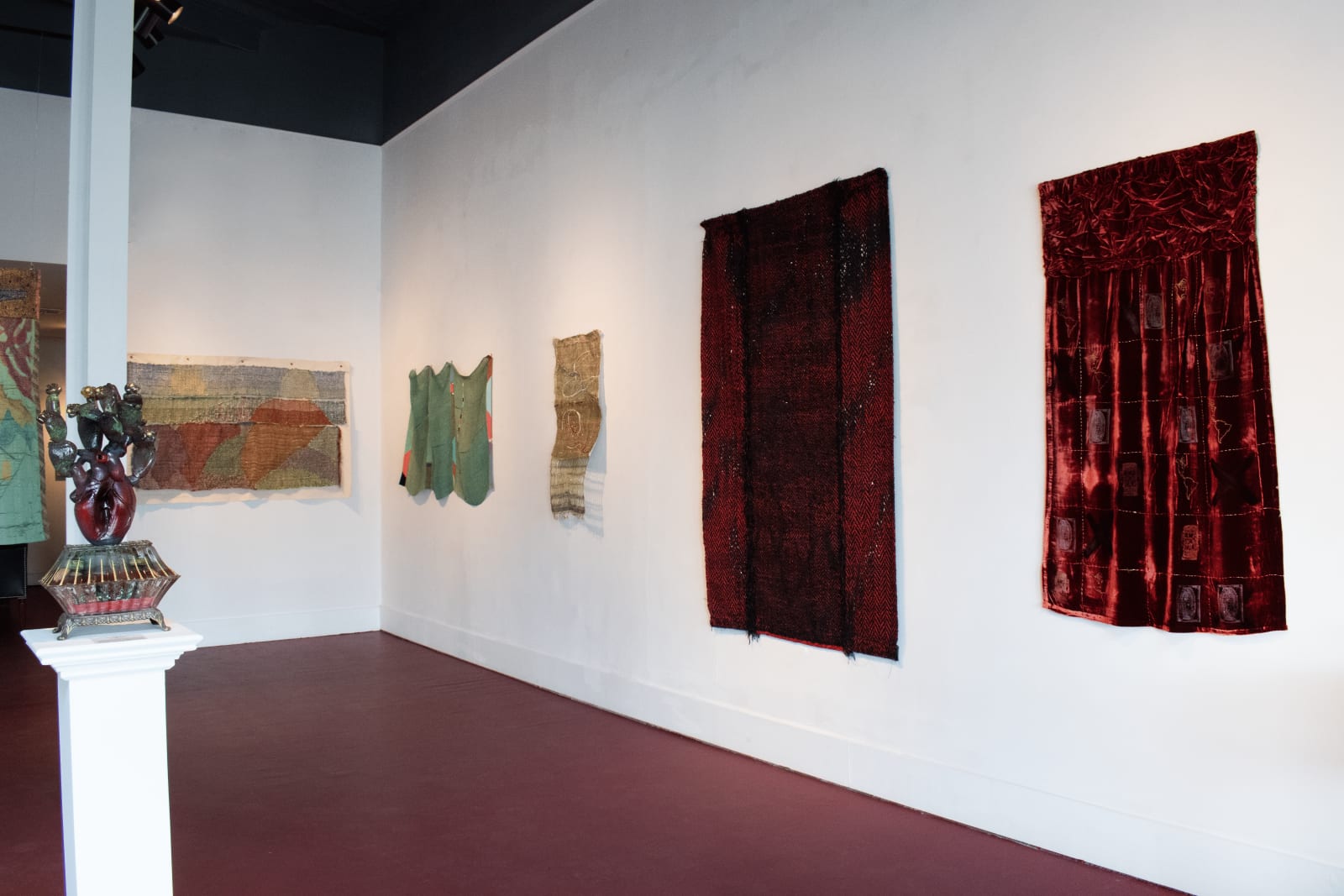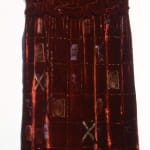




Consuelo Jimenez Underwood American, b. 1949
American Dress. Virgen de Tepin (Chili), 1999
Stitched, silkscreened, painted, embroidered. Silk velvet, gold wire, barbed wire, textile paint
56 x 34 in
142.2 x 86.4 cm
142.2 x 86.4 cm
Further images
Part of Jimenez Underwood’s American Dress triptych, this huipil-inspired wall hanging is dedicated to chili. Virgen de Tepin references a garment and a map, as its delicate golden grid line...
Part of Jimenez Underwood’s American Dress triptych, this huipil-inspired wall hanging is dedicated to chili. Virgen de Tepin references a garment and a map, as its delicate golden grid line suggests. The lush velvet canvas contains barbed wire and silk-screened images, some of them covered with an “x”. The artist explains: “The intent was to depict the physical rape of the Americas, with the ancient deities watching…I tried to match the red color to the chile tepin, one of my favorite American spices, which still grows wild in some parts of Mexico. The barbed wire represents the colonial domination of the continent.”
"In the American Dress triptych, Jimenez Underwood celebrates the trinity of chili, cacao, y nopal as markers of Indigenous identity and as much-appreciated gastronomic gifts from the American earth." Ann Marie Leimer, "Garments for the Goddess of the Americas", Consuelo Jimenez Underwood Art Weaving, Vision, Duke University Press, 2022
"In Spain, I was surprised at the absence of black pepper on dining tables. Once home, enjoying my spicy cuisine, I reaffirmed my self-identity – of course, I wasn’t Hispanic! In gratitude, I stitched the Tepin (a spicy yet inviting pepper) spirit as a lush, crushed red velvet dress embroidered with golden grids and crossed-out harsh memories. I silkscreened with ancient and contemporary Mexican maternal deities. Gold-wrapped barbed wire bits are snuggled inside the soft and voluptuous material, dangerous to the incautious viewer. Now, whenever I travel, I bring my supply of crushed chile." Consuelo Jimenez Underwood
"In the American Dress triptych, Jimenez Underwood celebrates the trinity of chili, cacao, y nopal as markers of Indigenous identity and as much-appreciated gastronomic gifts from the American earth." Ann Marie Leimer, "Garments for the Goddess of the Americas", Consuelo Jimenez Underwood Art Weaving, Vision, Duke University Press, 2022
"In Spain, I was surprised at the absence of black pepper on dining tables. Once home, enjoying my spicy cuisine, I reaffirmed my self-identity – of course, I wasn’t Hispanic! In gratitude, I stitched the Tepin (a spicy yet inviting pepper) spirit as a lush, crushed red velvet dress embroidered with golden grids and crossed-out harsh memories. I silkscreened with ancient and contemporary Mexican maternal deities. Gold-wrapped barbed wire bits are snuggled inside the soft and voluptuous material, dangerous to the incautious viewer. Now, whenever I travel, I bring my supply of crushed chile." Consuelo Jimenez Underwood
Exhibitions
Threading Glass: Consuelo Jimenez Underwood, and Einar and Jamex de la Torre, Ruiz-Healy Art, San Antonio, TX, 2025Consuelo Jimenez Underwood: Threads from Border-landia, Ruiz-Healy Art, New York, NY, 2022
Literature
Laura E. Perez and Ann Marie Leimer, eds., Consuelo Jimenez Underwood: Art, Weaving, Vision, Durham, North Carolina: Duke University Press, 2022, between pages 90-91 (illustrated)





